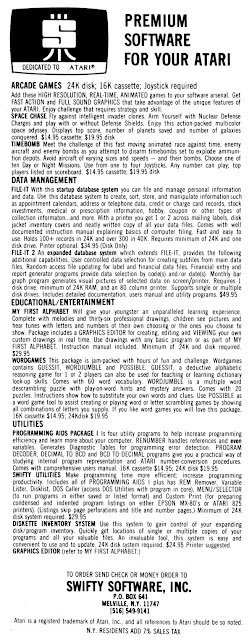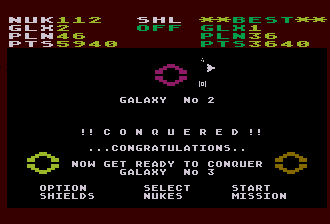Coming up next in the whale watch is Boulder Dash, one of two games that its developer First Star Software is best known for. The other, Spy vs Spy, appears later the same year. This post concerns the earliest games by First Star's most directly involved founder, Fernando Herrera.
 |
| Scan by Atarimania |
With a background in architecture and industrial engineering, Herrera was an early adopter of Atari computers, quickly learning how to write software, which he published through Swifty Software, a one-man publishing house operating as a Long Island schoolteacher's side hustle. First creating programmer's tools, and then a vector-based graphics editor, the program that caught Atari's attention and kickstarted his career was My First Alphabet, a BASIC program that he originally wrote for his 3 year old son, who had suffered from cataracts since birth. My First Alphabet was added to the APX catalog in late 1981, and won the first Atari Star Award, a quarterly cash prize of $25,000 awarded in recognition of the best submission to the catalog. With this award came publicity, prestige, more sales, and inspired the namesake of the company Herrera would soon found.
 |
| And ass-kissing. |
As for My First Alphabet, there's not much point in evaluating it with a critical eye. The engine draws pictures of things line-by-line, in the same style as Sierra's adventures, and prompts you to type the letter that the thing begins with. Sometimes, instead of letters, you have to count glasses of milk and type the corresponding number key. Correct keypresses are rewarded with shows of color and music. Some children's software holds adult appeal, but this one doesn't, and I can't imagine it impressing any toddlers today.
One curiosity is that the main menu holds a "graphics editor" option, which prompts you to insert disk 2. The original release through Swifty Software would have come with this disk, and the APX catalog sold it separately, but alas, neither version has been dumped, so it remains unavailable.
My First Alphabet was re-released as a regular Atari product the following year, and this version features mostly different pictures and things - for instance, instead of an apple, there's an animated airplane, instead of counting glasses of milk, you count clowns, and the "graphics editor" option is removed.
In 1982, Herrera submitted one of his games from Swifty's arcade lineup to APX, to less acclaim, but perhaps more substance for the modern gamer to digest.
Game 291: Space Chase
For a change of pace, your goal is to conquer the galaxy rather than to save it. To do this, you fly your ship over every planet in the galaxy while chased by pursuing TIE fighters, and if one of them touches you, then as the game says, only cosmic dust will be left. You can get them off your tail by dropping nuke mines, but they respawn infinitely. In most cases, it's better to fly off the edge of the screen and wrap around to the other side, forcing them to approach you by the long route. Planets may also be destroyed by accidentally or purposefully allowing TIE Fighters to fly over them, which removes them from the screen but also denies you points for conquering them.
In between levels, you can restock nukes, setting your stock to either 125, 25, 5, or 1, but I can't see much reason why you'd want to set it to anything but 125, even if they aren't all that useful. You may also turn your shields on and off, but all your shields do is protect you from your own nukes, while also cutting your points earned in half. I don't think I ever touched my own nukes even once.
GAB rating: Below average, and that's generous. Space Chase is amateurish stuff, too simple to sustain interest for long, and looks and plays pretty rough. But I've seen worse, even from professional channels.
Later that year, Herrera partnered with Hollywood producers Richard Spitalny and Billy Blake, and founded First Star Software, a name referencing Atari's Star Award.
Game 292: Astro Chase
SINGLE THRUST PROPULSION could cause a minor revolution in programming video games and computer games, boasts the back of the box. What does it mean? It means you can move in one direction while shooting in another, but it also means you have no way to make your ship stop moving, ever. Robotron: 2084 did the same thing much more elegantly the same year, and didn't feel the need to self-aggrandize the feature or even call attention to it, simply allowing the dual joystick' labels to inform you of their respective purposes.
Astro Chase certainly looks nice, anyway. You couldn't beat the Atari for color depth until several years after its release, and Herrera puts it to good use in a way that isn't comparable to anything I've seen from its era, even in arcades. Cut-scenes in between sets of waves return you to earth, where ticker-tape parades may or may not march in your honor, depending on how far you get.
The game plays like a multi-scrolling but otherwise simplified Defender, where you have to protect the earth from 32 waves of Mega Mines and increasingly powerful interceptors. You can start on any wave from 1 to 24, but if you really want to win, you'll need to start on the easiest rounds to rack up as many extra lives as possible. That said, if even one mine gets through, the earth is destroyed and you lose them all.
Navigating the stage can be pretty frustrating, as an invisible force-field keeps you from straying far from earth, which is a good thing, but the fact that it's invisible means you get bounced back without warning while trying to pursue a mine just out of reach. Equally frustrating are the difficult to spot stars, which serve as obstacles even though perspective rules would dictate that they are several astronomical units away from the plane of action.
Energy is limited but replenishable in a suitably annoying way - refuelling stations placed in the far corners of the playing field mean you risk Terran annihilation by merely visiting them, and the longer you stand by, filling up your reserves, the more you risk the earth's destruction in your absence. Better to refuel at the end of a wave when there's only one mine left and you have some idea of where it is. You can get virtually unlimited energy, but one hit from an enemy and you lose it all except for the standard 1000 units that you'll always spawn with.
GAB rating: Average. Ultimately, Astro Chase didn't entertain me nearly enough to stick with it all the way to the end, and the twitchy controls and odd gameplay mechanics made for a bit of a learning curve, but I did have some fun for the brief period of time between getting its controls and exhausting its gameplay possibilities.
Coming up next is Boulder Dash, the first game of 1984 that I'm genuinely excited to play for the first time.














Boulder Dash! One of my all-time favorite Game Boy games!
ReplyDelete